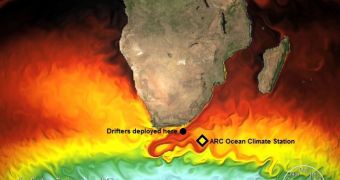The warm oceanic Agulhas Return Current (ARC), which is located southeast of South Africa, is now the target of a new climate investigation carried out by American researchers at the US National Oceanic and Atmospheric Administration (NOAA).
This research is conducted so that researchers can get a clearer picture of the relationships that develop between local weather, the global climate and the ocean in this little-studied area of the world.
NOAA experts from the Pacific Marine Environmental Laboratory (PMEL) deployed and installed an Ocean Climate Station mooring on the edge of the ARC. The anchored buoy is capable of collecting data on all significant oceanic traits at this location.
Throughout tropical latitudes, buoys have been installed years ago, but the areas below the Tropic of Capricorn have been investigated by far too few experts. Climate data collected here could help fill the puzzle that is the global weather pattern.
Only two deep-ocean buoys exist south of this Tropic. The newly-installed mooring is one, and the other is located south of the Australia.
Scientists with NOAA believe that this buoy will help with their climate observation and monitoring efforts, which now spread over large portions of the entire globe.
“With this mooring, we will be able to measure how this powerful current warms the atmosphere and some of the effects this has on the local meteorology and climate,” explains Meghan Cronin, PhD.
“More heat is released to the atmosphere in the ARC region than anywhere else in the entire Southern Hemisphere. This heating can affect winds, clouds and rainfall over a broad region,” adds Cronin, the PMEL principal investigator and oceanographer.
“The buoy will also carry sensors to measure how much atmospheric carbon dioxide is absorbed into the ocean in this critical region for the global climate system,” adds Christopher Sabine, PhD.
The expert holds an appointment as an oceanographer at PMELm and is also a participant in the ARC project. He says that ARC is similar in function to the Gulf Stream in the North Atlantic and the Kuroshiro Extension in the North Pacific.
Both NOAA and the US National Science Foundation(NSF) supported PMEL in designing, building and deploying the heavily instrumented ARC surface buoy.
The station contains sensors capable of measuring wind, air temperature, relative humidity, rain, solar and infrared radiation, barometric pressure, sea surface temperature and salinity, and near-surface currents.
“Building a buoy to collect and transmit reliable data requires teamwork between the engineers and the scientists,” explains the director of PMEL engineering, Chris Meinig.
“Because of the location off South Africa, we had to carefully design, model and build something that has a chance of withstanding the violent weather, steep waves and strong currents,” he concludes.

 14 DAY TRIAL //
14 DAY TRIAL //